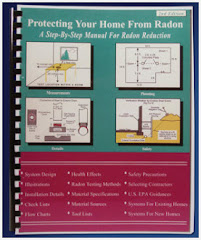I traveled up to Goodlettsville today, to install a basic radon mitigation system. Of course I had to do the standard diagnostic testing for adequate airflow under the basement concrete slab before I began installing the main system. In this case the house failed the test, so it was a complete wasted morning-no installation occurred.
I think from now on, I will charge $75.00 for the diagnostic part, applicable towards the original estimate if the house passes the test, otherwise I lose that amount on travel expense and labor.
In this particular case, the concrete was about 10" thick and directly on dirt, so there was no crossflow of air to work with:
Concrete Basement
Client wants the pipe to come through the concrete wall to the outside, here.
Time to christen my new and improved Bosch hammer drill
The pilot hole from the outside comes through the basement wall at a good spot and luckily not into that black pipe there.
We'll need a 3 5/8 diameter hole, here.
...But first we have to check beneath the concrete floor for a gravel-layer. X marks the spot.
"Ready for Radon"
This time, a 1 inch bit will be needed.
My small industrial vac with a big motor.
The work area.
So far, 10" of concrete and no sign of gravel. Maybe we're too close to the wall? The new Bosch hammer drill performs amazingly well in concrete and it doesn't try to tear my arm off, unlike the el-cheapo hammer drill I used from 2008 through last month.
5" further in should get us away from the footer.
This time we hit some hard-packed dirt at about 8", but no gravel to be found. I will recommend a heat recovery ventilator. A subslab ventilation system will likely fail.
Concrete in a tube to patch the test-holes.
And some foam backing-rod filler.
We were never here......
I also patched the smaller hole to the outside.
Wasted trip. At least the dog was friendly.






























































